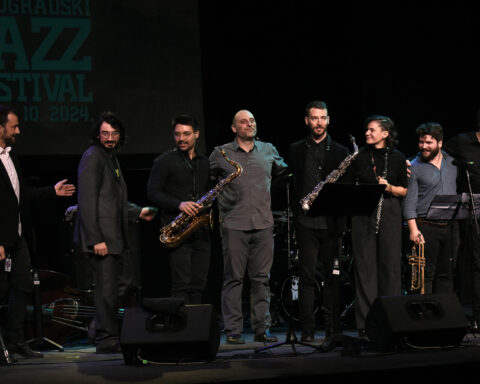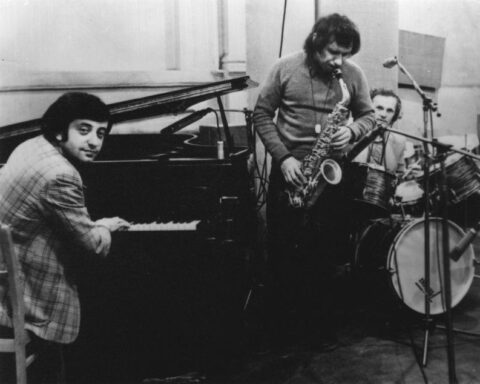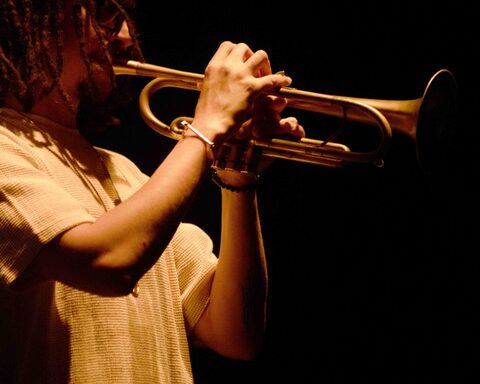The story is like a fairytale, one that is almost impossible to believe or for a child to understand. It is the story of the short life of Charlie “Bird” Parker, arguably the greatest jazz musician of all time. Yet if a dozen knowledgeable musicians were asked details about the life of Charlie Parker there is a good chance that a dozen different answers would result.

That fact underscores the significance of the newly mounted exhibit presented by the American Jazz Museum in conjunction with the University of Missouri, Kansas City. Saxophone Supreme: The Life and Music of Charlie Parker is the first exhibit that Executive Director, Rashida Philips, has presented in the museum’s Changing Gallery since her tenure began.
Rashida Phillips comes to Kansas City from St Louis, by way of Chicago. The new director’s time at Rutgers University prepared her well for a position that honors the legacy of jazz history, and she confidently opened the Parker exhibit’s first showing by singing a swingin’ a capella version of Bird’s composition Yardbird Suite. The new director’s brief vocal was as fitting to the opening ceremony as alto saxophonist Bobby Watson’s solo performance, which took the crowd on a quick trip through the museum.

The term “Saxophone Supreme” comes from an ad in the Kansas City Call, for a dance on Christmas night, 1938 featuring Harlan Leonard and the Rockets. Leonard’s holiday performance featured Parker, long before he left Kansas City for New York. Bird was still a teenager, but bandleaders already knew that the young man’s presence in the sax section of a dance band was a big draw.

The exhibit Saxophone Supreme celebrates the Centennial of the birth of Charlie “Bird” Parker, one of the most influential musicians and composers of all time. He was born August 29th, 1920, was raised in Kansas City on both sides of the state line and is buried in Blue Summit, on a small strip of land adjacent to the city and the city of Independence, MO.
Bird was among elite group of free-thinking young musicians who pioneered a style of music known as bebop, a revolution in jazz. His influence and stature have not waned in the almost 50 years since his untimely death.

Throughout his short career, Parker continued to innovate and explore new musical vistas, influencing ensuing generations of musicians across a broad range of styles. His profound genius continues to inspire writers, artists, dancers and filmmakers alike.
A Facebook post I came across in late July is a good example of Parker’s far-reaching influence. The post was written by trumpeter Mike Steinel, a composer and professor of trumpet emeritus of the Jazz Studies Division at the University of North Texas, where he’s been for more than 30 years. Mike is a recording artist and highly acclaimed for his book, Essential Elements for Jazz Ensemble and Building a Jazz Vocabulary.
He decided in early April to begin working through the Charlie Parker Omnibook – transposing every bar of every solo into all 12 keys and then playing them on his trumpet. He anticipated he would complete the project by July 20. Steinel’s pandemic project helps to further honor and unpack the gifts of Parker that continue to inspire musicians today. Here’s the post:
“Finished today. (Ballade – Page 142). I have been marking interesting bits with ‘stars’ and ‘question marks’ and now I will go back and try to analyze what Bird was doing. I will continue to steal the best stuff.
“Big take-away: Parker’s one measure vocabulary avoids the note that he is headed toward in the next measure (most often on beat one). He seems to have a goal in mind at every moment. His goals have harmonic strength, melodic interest, and rhythm drive. He pulls our ear ahead and keeps us interested as we listen.
“He commands our attention and continues to surprise us. This might be a good metaphor for everything in life. If we can maintain clear, beautiful and noble goals in each moment of our lives, all the big stuff will work out. Our present situation (with the virus) has clouded our horizons and robbed us (in a way) of a clear future. It’s hard to plan ahead. Best we can hope for is to live moment to moment and love those around us. And wear a mask. Peace.”

The show at the American Jazz Museum is the fruition of a budding partnership between the museum and the UMKC Libraries that has been brewing for many years. This exhibit assembles a vast collection of photographs from the LaBudde Library and the succinct storytelling of Marr Sound Archives founder and Charlie Parker biographer Chuck Haddix, whose 2013 book entitled BIRD: The Life and Music of Charlie Parker will be published in Japan on August 29.

Haddix curated Saxophone Supreme with Geri Sanders, the AJM’s Senior Manager of Collections, UMKC Associate Dean of Special Collections Sandy Rodriguez and Derek Long, head of the Marr Sound Archives. Sean McCue, Graphic Designer for UMKC Libraries added clean graphics and a pleasing color scheme to the vertical panels that make up much of the show.

Saxophone Supreme is free and open to the public in the Changing Gallery of the American Jazz Museum at 18th and Vine Tues. through Sat. 10:00am – 5:00pm, Sun. 10:00am – 4:00 pm. For more information on the museum’s updated admissions process, please visit AJM’s website.
David Basse, editor of JAM magazine, is heard on 50 radio stations, providing 15 hours of music weekly as Jazz with David Basse.





